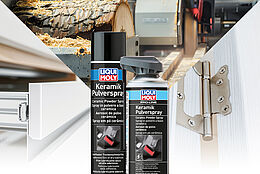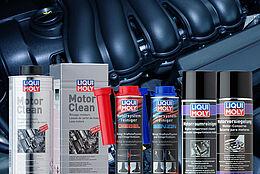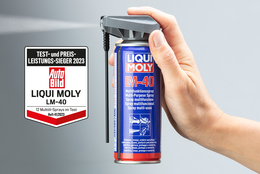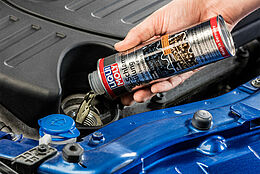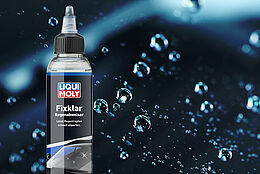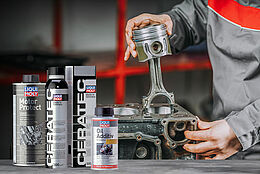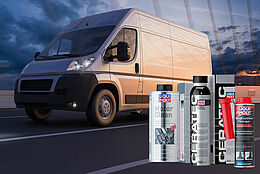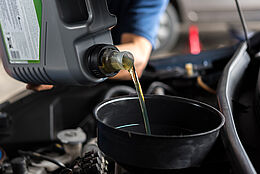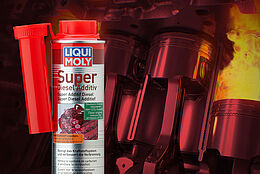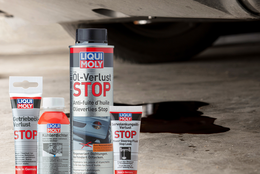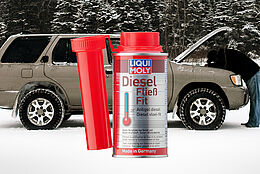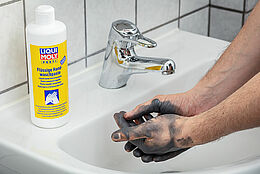- 6min
Proven engine wear protection with Cera Tec

High loads or even normal operation cause wear in the engine, which can sooner or later lead to something in the engine no longer functioning properly. A scenario every driver would prefer to avoid. To protect the engine from excessive wear and thus optimize its service life and efficiency, we recommend using our Cera Tec oil additive.
How does it work?
The surfaces of metallic components always have tiny irregularities or roughness. If they rub directly against each other, this can lead to wear and damage in the long term.
The chemical agent (“friction modifier”) smooths the surfaces without abrading them: The existing frictional energy results in a flowing, non-abrasive smoothing through the friction modifier.
In addition, the ceramic particles with a graphite-like structure fill in the small unevenness in the metal and thus prevent the metal surfaces from rubbing directly against each other.
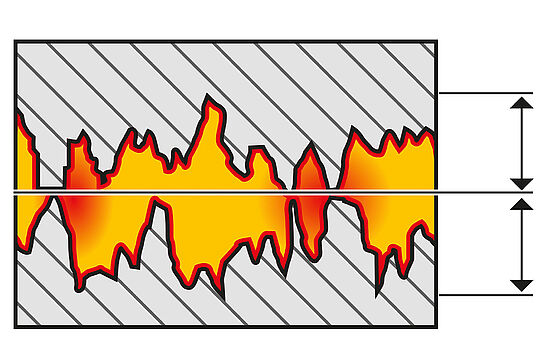

How the effectiveness of Cera Tec was tested
Six percent Cera Tec was added to the test oil at the test bench. With each test sequence, the weight and thus the force level on the sensitive gear wheels was increased. The aim of the experiment is to reach the damage force level. This level is reached when the sum of all damage caused to the teeth of the gears is more than 20 millimeters. The test is then ended.
The reference oil reached damage force level 4. The oil mixed with Cera Tec reached as far as level 9, i.e. more than twice as much. “Cera Tec significantly increases the performance reserve, which confirms the wear protection provided by the fine ceramic particles,” is how Dipl.-Ing. Peter Kunz, who supervised the test, summarizes the results. Kunz’s initial skepticism was blown away: “I was amazed at the test results. The product made everything, but really everything, better.”
The request for APL’s expertise was itself unusual. “LIQUI MOLY is the first company in the aftersales market that has been prepared to carry out voluntary tests,” says Kunz. He is responsible for all lubricant and fuel tests.
About Automobil-Prüftechnik-Landau GmbH (APL)
Founded in 1989, APL is a neutral, independent development service provider with an international reputation. Its customer base includes companies worldwide from the automotive, oil and additive industries. The company specializes in the mechanics of engines and drive trains as well as their operating fluids. More than 700 employees use the latest measurement technology at some 145 state-of-the-art engine and component test benches.

Using Cera Tec correctly
It’s easy to use: Add the additive directly to the motor or gear oil – whether cold or warm. For optimal performance, we also recommend the following:
- Ideally, pour in Cera Tec together with the fresh oil when changing the oil.
- One full can (300 ml) used with 3–5 Liters (3.2 to 5.3 U.S. Qts) of motor oil. Long-term effect up to 50,000 km (30,000 miles). Shake well before use. Not suitable for use with DSG/DCT-, automatic-transmissions or wet-clutch differentials. For best protection, use with every oil change.
- Observe the oil change intervals according to the vehicle’s service documents.
In a nutshell: why Cera Tec is well worth it
Cera Tec is an high-tech anti-wear additive, suitable for most 4-stroke engines as well as manual transmissions and compressors. This can result in a lower susceptibility to repairs and a longer service life.



